Is RBI’s 25 bps repo rate hike the last one?
Reserve Bank of India’s recent repo rate hike to the tune of 25 basis points is broadly in line with the bank’s assessment about resilience of the Indian economy and the challenges ahead
image for illustrative purpose

The Reserve Bank of India’s recent repo rate hike to the tune of 25 basis points is broadly in line with the bank’s assessment about resilience of the Indian economy and the challenges ahead. Going forward, expect a stimulus to the growth trajectory as projected by the central bank, by reverting to an accommodative policy stance with regard to benchmark interest rates.
The constant increase in Federal Funds Rate makes it difficult for the central banks to come up with an effective monetary policy for an emerging economy. With the US job market continuing to be significantly resilient given the latest data, it seems likely that Fed rate hike could continue even beyond March.
Against this background, there is an active debate on the timing and sequencing of monetary stance around the world. The exit from the current policy increases should, however, be different across countries, depending on the balance of risk to growth and price stability.
The April monetary policy statement of RBI thus assumes special importance on whether we can signal an exit from coordinated monetary policy increases, as, otherwise, it could become a self-fulfilling prophecy of central banks of emerging markets doing a continuous catch up with the Fed.
Between April 2022 and this month, with coordinated monetary policy actions, spread between Fed Funds Rate and Repo Rate of cumulative increases has now declined to 192 basis points. Interestingly, the spread is now constant at 192 basis points since December. With Fed likely to go for further rate hikes in March, and beyond, the spread would compress, provided there is no further rate hike by RBI.
An Ecowrap study finds evidence that synchronized rate actions have resulted in increased market volatility from pre-pandemic levels with the rate increases from April, though such volatility is lower than what it was during pandemic levels. Else, the policy has unleashed a bouquet of measures to attend the microstructure of markets.
Apart from the domestic inflation trajectory, the RBI actions will continue to be influenced by the actions of Global Central banks, especially the US Fed. Inflation has started to moderate both domestically and globally but at the same time global and domestic growth has been holding up beyond expectations.
Despite weak US Dollar and our twin deficits (fiscal and current account), the rupee has underperformed of late. Hence, we need to maintain interest rate differentials with developed economies especially with US, which has been falling since last year.
RBI has, since last May, effectively hiked the operational rate by 315 bps (from reverse repo of 3.35 per cent to 6.50 per cent repo rate). Experts believe that RBI may not hike any further as with current operating monetary framework the MSF rate (marginal standing facility) at 6.75 per cent can become the operational rate if liquidity enters negative zone. Time, the accommodative stance of RBI, was back to the pavilion.

